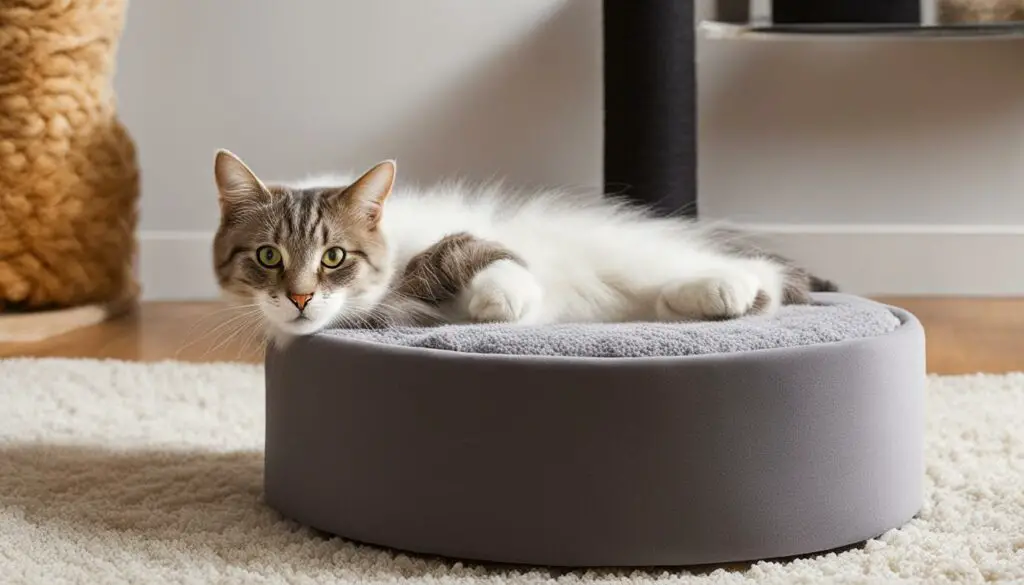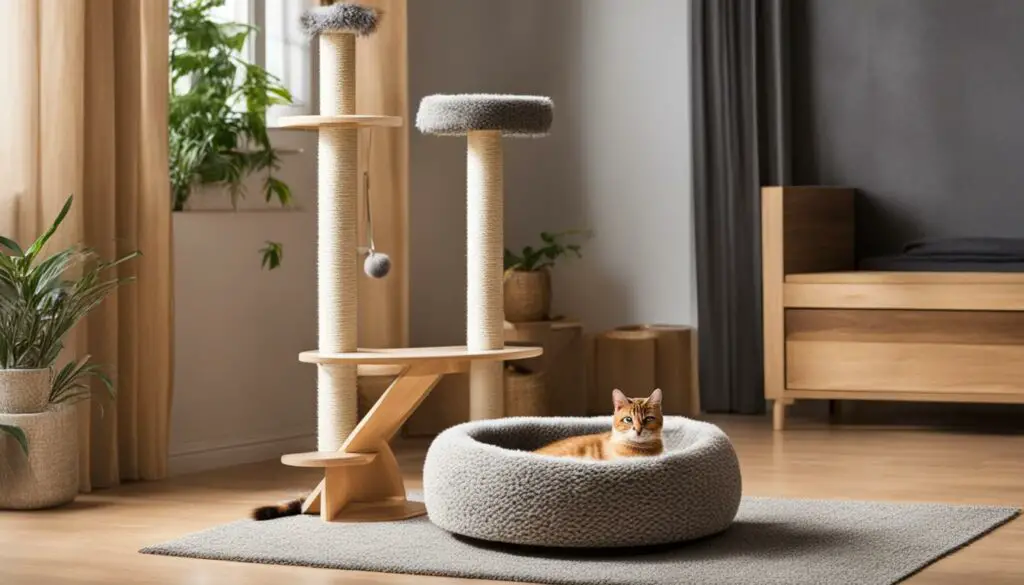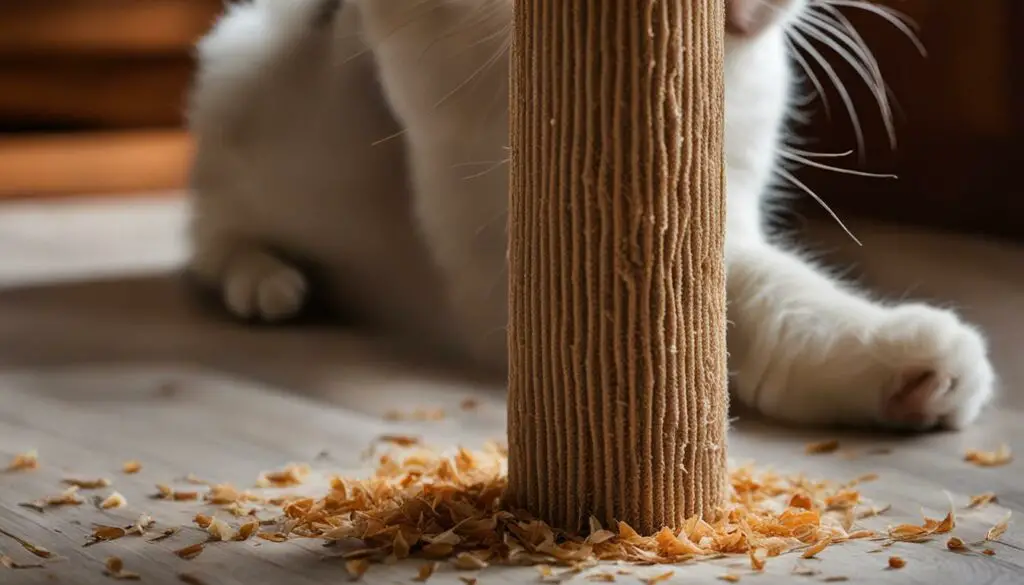Have you ever wondered why your cat seems determined to scratch your TV? It’s a common behavior that many cat owners find frustrating. Understanding the reasons behind this scratching behavior can help you find effective solutions to protect your TV and redirect your cat’s attention. Let’s delve into the world of cat scratching behavior and explore the reasons why cats scratch the furniture, including the TV, and how to discourage this habit.
Key Takeaways:
- Cats scratch to express emotions, mark objects, remove dead nail parts, and stretch.
- Providing a suitable scratching post or surface is crucial to redirect your cat’s behavior.
- Understanding your cat’s motivations and providing mental and physical stimulation can help prevent scratching.
- Choosing the right location for the scratching post can increase its appeal to your cat.
- Training, positive reinforcement, and deterrents can discourage your cat from scratching the TV.
The Importance of Providing a Suitable Scratching Alternative
Redirecting your cat’s natural scratching behavior to more suitable alternatives is essential for preserving your furniture and preventing any damage to your TV. Cats are instinctively drawn to tall, sturdy objects like furniture, which is why it’s crucial to provide them with an appealing scratching option that meets their needs.

Table: Comparing Different Types of Suitable Scratching Alternatives
| Scratching Alternative | Description |
|---|---|
| Cat Scratching Posts | Tall, sturdy posts covered in sisal rope that mimic the texture of tree bark and appeal to your cat’s scratching instincts. |
| Sisal Scratching Rope | Loose sisal rope that can be attached to furniture legs or used to create a standalone scratching surface. |
| Horizontal Scratching Pad | A flat, horizontal surface covered in sisal or another suitable material that allows your cat to scratch and stretch. |
| Wood Scratching Surface | Sturdy wooden surfaces that can be placed vertically or horizontally to provide an appealing and durable scratching option. |
Every cat is unique, so it’s important to observe their preferences and provide a variety of suitable scratching alternatives. Some cats prefer vertical scratching while others prefer horizontal scratching. Experiment with different options and observe which ones your cat gravitates towards. By offering a suitable scratching alternative, you can redirect your cat’s attention away from your furniture and discourage them from scratching your TV.
Choosing the Right Location for the Scratching Post
When it comes to addressing your cat’s scratching behavior, the location of the scratching post plays a crucial role. Cats have specific preferences when it comes to scratching, and understanding their behavior can help you determine the ideal location for the scratching post.
Scratching near furniture: If your cat tends to scratch the furniture, it’s best to place the scratching post next to these areas. By doing so, you are providing a convenient alternative that encourages your cat to redirect their scratching behavior towards the post.
Scratching by the front door: Some cats have a habit of scratching near the front door. Placing the scratching post in close proximity to this area can help deter them from scratching the door and instead focus their attention on the post.
By strategically placing the scratching post in locations that align with your cat’s scratching habits, you are more likely to successfully redirect their behavior and prevent damage to your furniture or door.

Table: Ideal Scratching Post Locations
| Scratching Behavior | Ideal Scratching Post Location |
|---|---|
| Scratching near furniture | Next to the furniture |
| Scratching by the front door | Near the front door |
Placing the scratching post in the right location is just one aspect of encouraging your cat to use it. It’s also important to provide a scratching post that meets your cat’s preferences in terms of height, material, and stability. By understanding your cat’s scratching behavior and providing suitable alternatives, you can help redirect their scratching habits and protect your furniture.
Understanding Your Cat’s Behavior and Motivation to Scratch
When it comes to feline behavior, understanding why cats scratch is crucial in finding effective solutions. Scratching is a natural instinct for cats and serves several purposes. It helps them mark their territory, remove dead parts of their nails, and stretch their muscles. However, scratching can also be a source of frustration for cat owners, especially when it leads to damage to furniture or, in some cases, the TV.
To address scratching behavior, it’s important to consider the cat’s nature and motivation to scratch. Cats scratch out of instinctive behaviors, but factors like scratching anxiety and changes in the household routine can contribute to increased scratching. For example, if a cat is stressed or bored, they may resort to excessive scratching as a way to alleviate their anxiety or release pent-up energy.
Redirecting your cat’s scratching behavior starts with providing suitable alternatives and addressing any underlying issues. This can include providing a variety of scratching surfaces, such as scratching posts or pads made of different materials like sisal or wood. Additionally, ensuring your cat has a routine and plenty of mental and physical stimulation can help minimize stress and boredom, thus reducing the likelihood of destructive scratching.

Understanding Your Cat’s Behavior
By observing your cat’s behavior and environment, you can gain valuable insights into their scratching habits. Pay attention to where and when your cat tends to scratch, as this can help identify their preferred scratching surfaces and any triggers that may be causing excessive scratching. This information can then guide you in providing the appropriate scratching options and making necessary adjustments to prevent unwanted scratching.
| Cat’s Nature | Cat’s Motivation |
|---|---|
| Cats have an instinctive need to scratch. | Scratching helps them mark territory and stretch their muscles. |
| Cats may scratch more when they are stressed or bored. | Scratching can alleviate anxiety and release pent-up energy. |
| Providing suitable alternatives can redirect their scratching behavior. | Addressing underlying issues can help reduce excessive scratching. |
Understanding your cat’s behavior and motivation to scratch is crucial in finding effective solutions.
Redirecting your cat’s scratching behavior requires patience, consistency, and a holistic approach. By understanding your cat’s needs and providing suitable alternatives, you can help them express their natural instincts without resorting to destructive scratching. Remember to address any underlying issues that may be contributing to excessive scratching, such as stress or changes in the household routine. With time and understanding, you can create a harmonious environment that satisfies both your cat’s needs and your desire to protect your belongings.
Decreasing Stress and Boredom to Prevent Scratching
Reducing stress and boredom in your cat’s daily routine is essential for preventing scratching behavior. Cats, like humans, need mental and physical stimulation to stay happy and healthy. By providing a structured environment and engaging activities, you can minimize the likelihood of your cat resorting to scratching as a means of relieving stress or boredom.
To decrease stress, establish a consistent daily routine for your cat. Cats thrive on predictability and knowing what to expect each day. Set regular feeding times, play sessions, and quiet moments for relaxation. This routine will help your cat feel secure and reduce anxiety, which can contribute to excessive scratching.
In addition to a routine, provide your cat with plenty of mental and physical stimulation. Engage in interactive play sessions using toys that mimic prey-like movements, such as a feather wand or a laser pointer. This type of play not only provides exercise but also gives your cat an outlet for their hunting instincts. Puzzle toys and treat-dispensing toys can also keep their minds occupied and prevent boredom.
| Ways to Decrease Stress and Boredom in Cats | Benefits |
|---|---|
| Regular play sessions | Provides mental and physical stimulation, reduces stress |
| Interactive toys | Mimics hunting behavior, keeps cats engaged |
| Puzzle toys | Keeps cats mentally stimulated, prevents boredom |
| Vertical spaces | Provides opportunities for climbing and exploration |
Incorporating vertical spaces into your cat’s environment is also important. Cats naturally love to climb and explore high places. Install shelves, cat trees, or provide access to windowsills to give your cat the opportunity to observe their surroundings from an elevated position. Vertical spaces not only provide mental stimulation but also offer an alternative surface for scratching, such as a vertical sisal scratching post.
By decreasing stress and boredom in your cat’s life and providing a stimulating environment, you can help prevent destructive scratching behavior. Remember to be consistent with your routine and offer a variety of engaging toys and activities to keep your cat happy and fulfilled.

Physical Changes in the Household to Prevent Scratching
When it comes to preventing your cat from scratching unwanted surfaces, making physical changes in the household can be highly effective. By cat-proofing certain areas and providing accessible scratching sites, you can redirect their behavior and protect your furniture.
To begin, confining your cats to a single room can limit their access to scratched surfaces and help establish a designated area for scratching. This room should be equipped with essential cat supplies, such as a scratching post, toys, food, water, and a litter box.
In addition to confining your cats, it’s important to cat-proof other areas of the house where scratching is a concern. This can be accomplished through the use of deterrent sprays or tapes, which have an unpleasant taste or texture that cats dislike. However, it’s crucial to be cautious when using sprays near electronic devices to avoid any potential damage.
| Scratching Prevention Tips | Cat-Proofing Techniques |
|---|---|
| Confining cats to a single room | Using deterrent sprays or tapes |
| Providing a designated scratching area | Protecting furniture with covers |
| Placing scratching posts near problem areas | Removing access to scratched surfaces |
By implementing these physical changes in the household, you can effectively prevent your cats from scratching unwanted surfaces and redirect their behavior to appropriate scratching sites.

Providing Suitable Scratching Options
When it comes to training your cat to scratch appropriate objects, it’s important to provide suitable scratching options. The timing of training is essential, and it’s best to start when the cat is around 8 weeks old. This is a critical period for their development, and they are more receptive to learning new behaviors.
One key aspect to consider is the suitable scratching surfaces. Cats have different preferences, so it’s important to offer a variety of options. Scratching posts are a popular choice, and they should be tall enough for the cat to stretch fully. A height of at least 32″ is recommended. The post should also be sturdy to prevent toppling during use.
Surface texture is another important factor to consider. Some cats prefer loosely woven material, while others may enjoy cardboard, carpet, wood, or sisal coverings. By providing a range of textures, you can determine what your cat finds most appealing. Observe their scratching behavior and adjust accordingly.
Table: Suitable Scratching Surfaces
| Surface | Description |
|---|---|
| Sisal Rope | Durable and commonly used for scratching posts. |
| Cardboard | Lightweight and disposable, great for horizontal scratching. |
| Carpet | Offers a softer texture for scratching. |
| Wood | Provides a natural and sturdy scratching surface. |
Remember, every cat is unique, so it may take some trial and error to find the best scratching options for your furry friend. The goal is to provide alternatives that satisfy their natural instinct to scratch while preserving your furniture and other valuable items.

By offering suitable scratching surfaces and ensuring the timing of training is appropriate, you can help redirect your cat’s scratching behavior in a positive way. Patience and consistency are key throughout the training process, as cats may take time to adjust to new habits and behaviors. With time and the right guidance, you can successfully train your cat to scratch appropriate objects and protect your home.
Luring Your Cat to the Scratching Post
When it comes to redirecting your cat’s scratching behavior, luring them to the scratching post can be a useful strategy. There are a few methods you can try to encourage your cat to use the scratching post instead of your TV. One option is to use pheromone sprays or catnip to attract your cat to the post. These scents can be highly enticing and help redirect your cat’s attention to the appropriate scratching surface.
Another way to lure your cat to the scratching post is by placing treats or toys near the post. By associating positive experiences and rewards with the scratching post, your cat will be more inclined to use it. Positive reinforcement is key in training your cat, and providing rewards for using the scratching post will help reinforce the desired behavior.

It’s important to remember that each cat is unique, and what works for one may not work for another. Experiment with different lures and rewards to find what motivates your cat the most. With patience, consistency, and positive reinforcement, you can successfully redirect your cat’s scratching behavior to the scratching post and protect your TV in the process.
Using Deterrents to Discourage TV Scratching
When it comes to preventing your cat from scratching the TV, deterrents can be an effective solution. Deterrent sprays and tapes are designed to create an unpleasant taste or texture that cats dislike, ultimately discouraging them from scratching. These products can be applied directly to the TV or the surrounding area to deter your cat from engaging in this behavior.

It’s important to choose deterrent sprays or tapes that are safe for electronic devices and won’t cause any damage. When using sprays, make sure to apply them at a safe distance from the TV to prevent any liquid from coming into contact with the delicate components. Always read and follow the instructions provided by the manufacturer to ensure proper usage.
In addition to using deterrents, it’s essential to provide your cat with suitable scratching alternatives. Remember, cats scratch to fulfill their natural instincts and needs, so make sure to provide them with a variety of scratching posts and surfaces that they find appealing. By redirecting their scratching behavior to appropriate objects, you can help protect your TV from any potential damage.
Training Your Cat Not to Scratch the TV
Training your cat not to scratch the TV requires patience, consistency, and positive reinforcement. By providing suitable alternatives, redirecting scratching behavior, and rewarding desired actions, you can alleviate your cat’s scratching habit and protect your television from damage.
One effective method is to redirect your cat’s attention to appropriate scratching surfaces, such as a designated scratching post or pad. Place the scratching post near the TV or in the area where your cat usually scratches. Encourage your cat to use the post by using toys or treats to lure them towards it. When they scratch the post, reward them with praise or a treat to reinforce the desired behavior.
Positive reinforcement is essential in training your cat. Whenever you catch your cat scratching the TV, calmly redirect their attention to the appropriate scratching surface. Reward them with treats or toys when they use the scratching post instead of the TV. Over time, your cat will learn that scratching the post is more rewarding than scratching the TV.
It’s important to remember that training takes time and consistency. Be patient with your cat and continue to reinforce the behavior you want. Consistently provide suitable scratching options and reward your cat for using them. Eventually, your cat will develop the habit of scratching the designated surfaces instead of the TV.

Summary:
- Training your cat not to scratch the TV requires patience and consistency.
- Redirect your cat’s attention to suitable scratching surfaces, such as a scratching post or pad.
- Use positive reinforcement, such as treats or toys, to reward your cat for using the scratching post.
- Training takes time, so be patient and continue to provide suitable alternatives and rewards.
Trimming Your Cat’s Claws
Trimming your cat’s claws is an important aspect of cat care that can help minimize the damage caused by scratching. Regular nail trimming not only keeps your cat’s claws shorter and less sharp, but it also reduces the likelihood of them accidentally scratching you or other household members. It’s a simple procedure that can be done at home with the right tools and a gentle approach.
When clipping your cat’s claws, it’s essential to use cat-specific nail clippers or human nail clippers with a straight edge. Avoid using scissors or clippers with a curved edge, as they can crush or splinter the claw. It’s also helpful to have styptic powder or cornstarch on hand in case you accidentally clip the quick, the pink part of the nail that contains blood vessels and nerves. If bleeding occurs, applying some styptic powder or cornstarch can help stop it.
Before trimming your cat’s claws, make sure they are relaxed and comfortable. Gently hold their paw and press on the pad to extend the claws. You’ll notice a translucent area near the base of the claw – this is the part you want to avoid cutting as it is sensitive. Carefully trim off the sharp tip of each claw, taking care not to cut too close to the quick. If your cat becomes agitated or stressed, it’s best to try again later or consult a professional groomer or veterinarian.

Incorporating regular nail trimming into your cat’s grooming routine can help minimize scratching damage to furniture, carpets, and other household items. It’s an essential part of responsible cat ownership and a way to ensure the well-being of both you and your feline friend.
Factors Contributing to Scratching Behavior
Understanding the factors that contribute to your cat’s scratching behavior is essential in addressing and managing this common issue. Cats may scratch due to various reasons, including stress, boredom, and underlying issues. By identifying these triggers and addressing them appropriately, you can help redirect your cat’s scratching behavior and prevent damage to your furniture and other valuable belongings.
Stress is a common factor that can lead to excessive scratching in cats. Changes in the household, such as moving to a new home, introducing new pets, or experiencing loud noises, can cause stress and anxiety in cats, prompting them to scratch more frequently. Providing a calm and stable environment, along with plenty of mental and physical stimulation, can help alleviate stress and reduce the likelihood of destructive scratching.
Boredom is another significant factor that can contribute to scratching behavior. Cats are natural predators and need mental and physical stimulation to stay happy and engaged. When they are bored, they may turn to scratching as a form of entertainment. Providing interactive toys, puzzle feeders, and regular play sessions can help keep your cat mentally stimulated and reduce their desire to scratch inappropriately.
“A cat will be more likely to scratch if they are stressed or bored. By addressing these underlying issues, we can redirect their behavior towards more appropriate activities.”
In some cases, scratching behavior may be a sign of underlying issues such as flea infestation, skin allergies, or medical conditions. If your cat’s scratching persists despite your efforts to address stress and boredom, it is advisable to consult a veterinarian. They can conduct a thorough examination to rule out any underlying medical issues and provide appropriate treatment or guidance.
| Factors | Effects |
|---|---|
| Stress | Promotes excessive scratching |
| Boredom | Leads to increased scratching behavior |
| Underlying issues | May cause persistent scratching despite addressing other factors |
In conclusion, understanding the factors that contribute to your cat’s scratching behavior is crucial in effectively managing this behavior. By addressing stress and boredom, providing appropriate mental and physical stimulation, and seeking veterinary guidance for underlying issues, you can redirect your cat’s scratching behavior and promote a harmonious environment for both you and your feline companion.

Consulting a Veterinarian for Persistent Scratching
If your cat’s scratching behavior persists despite your efforts, it may be beneficial to consult a veterinarian. A veterinarian can assess the situation and provide expert advice on managing the behavior. They can help determine whether there are any underlying medical issues or behavioral factors contributing to the persistent scratching.
A veterinary consultation is especially important if your cat’s scratching behavior is accompanied by other concerning symptoms, such as excessive grooming, skin lesions, or changes in appetite or behavior. These could be indicators of an underlying medical condition that needs to be addressed.
During the consultation, the veterinarian will conduct a thorough examination of your cat, taking into account their medical history and any relevant environmental factors. They may also recommend additional diagnostic tests or refer you to a veterinary behaviorist for further evaluation and treatment.
By seeking professional veterinary advice, you can gain a deeper understanding of your cat’s scratching behavior and receive tailored recommendations to address the issue. Remember, every cat is unique, and what works for one may not work for another. With the guidance of a veterinarian, you can develop a comprehensive plan to help redirect your cat’s scratching behavior and promote their overall well-being.

Time and Patience for Redirecting Scratching Behavior
In order to successfully redirect your cat’s scratching behavior, it is important to understand that it will take time and patience. Cats are creatures of habit and changing their behavior requires consistency and perseverance. By following the right steps and techniques, you can effectively modify your cat’s scratching habits and protect your TV from further damage.
Behavior modification takes time, and it varies from cat to cat. Some cats may respond more quickly to training, while others may require more time to adjust. It is essential to be patient and not get discouraged if you don’t see immediate results. Remember that cats have their own unique personalities and it may take a bit longer for some cats to break their old habits. Stick to the training routine and provide positive reinforcement to encourage your cat to use the appropriate scratching surfaces.
Consistency and Training
Consistency is key when it comes to redirecting your cat’s scratching behavior. Establish a regular training schedule and stick to it. Make sure that everyone in the household is on the same page and follows the same training techniques. This will help avoid confusion for your cat and ensure that they receive consistent messages regarding appropriate scratching behavior.
During the training process, provide suitable alternatives to the TV for your cat to scratch. Place a scratching post or a horizontal scratcher near the TV, ensuring they are accessible and appealing to your cat. Encourage your cat to use these alternatives by using pheromones, catnip, or placing toys nearby. When your cat scratches the appropriate surface, reward them with treats or praise to reinforce the desired behavior.
Remember, to effectively modify your cat’s scratching behavior, it is important to be patient, consistent, and understanding. With time, training, and suitable alternatives, you can redirect your cat’s attention and protect your TV from further scratching damage. By providing a positive and stimulating environment, you can help your cat develop new scratching habits that are acceptable and enjoyable for both of you.

Conclusion
After understanding the reasons behind your cat’s scratching behavior and the importance of providing suitable alternatives, you can take steps to redirect their attention and protect your beloved TV. Modifying your cat’s behavior requires consistency and patience, but it is possible to achieve positive results.
By training your cat to use a scratching post or alternative surfaces, luring them with pheromones or catnip, and rewarding their desired behavior, you can encourage them to scratch where it is appropriate.
Additionally, trimming your cat’s claws regularly can help minimize the damage caused by scratching. And don’t forget to address any underlying stress or boredom by providing a structured routine and mental and physical stimulation. This will help keep them engaged and less likely to engage in destructive scratching.
If you find that your efforts are not yielding the desired results, it may be beneficial to consult a veterinarian. They can determine if there are any underlying medical or behavioral issues contributing to the persistent scratching behavior.
Remember, redirecting your cat’s scratching behavior takes time and patience. By understanding their needs, providing suitable alternatives, and implementing consistent training, you can protect your TV and modify your cat’s behavior for a harmonious coexistence.
FAQ
Why does my cat scratch the TV?
Scratching is a normal, instinctive cat behavior. Cats scratch to express emotions, mark objects with their scent, remove dead nail parts, and stretch. They don’t have a concept of right or wrong, only meeting their needs.
How can I prevent my cat from scratching the TV?
Providing a desirable scratching post or surface is key to redirecting your cat’s behavior. Cats prefer tall, sturdy objects like furniture to scratch. Offering suitable scratching alternatives, such as a scratching post, can help deter them from scratching the TV.
What are the ideal scratching alternatives for cats?
Most cats prefer a scratching post that is at least 32″ tall, doesn’t wobble, and made of sisal rope. Some cats prefer scratching horizontally, so a sturdy sisal-covered pad or horizontal scratcher can be used. Wooden surfaces also make ideal scratching surfaces.
Where should I place the scratching post?
The location of the scratching post is important. If your cat enjoys scratching the couch or the wall near the front door, place the scratching post next to these areas. Cats are more likely to use a scratching post if it is conveniently located where they already have a tendency to scratch.
How can I understand my cat’s scratching behavior?
Understanding your cat’s behavior and motivation to scratch is essential to finding effective solutions. Indoor cats need outlets for scratching and marking territory. Anxiety or changes in the household can lead to increased scratching. Providing a regular routine and addressing anxiety can help redirect the behavior.
How can I decrease stress and boredom to prevent scratching?
Stress and boredom can contribute to destructive scratching behavior. Providing a structured routine, social play, object play, and exercise can help minimize stress and boredom, reducing the likelihood of scratching. Mimicking a cat’s natural prey-hunt-eat-groom-sleep routine can provide a healthy balance.
Are there any physical changes I can make in my household to prevent scratching?
Sometimes making physical changes in the household is necessary to prevent scratching. Cat-proofing certain areas or confining cats to a single room can limit access to scratched surfaces. It’s important to provide a scratching post, toys, food, water, and litter box in the designated area.
How do I train my cat to scratch appropriate objects?
Training a cat to scratch appropriate objects involves providing suitable scratching options. Start training when the cat is around 8 weeks old. Scratching posts should be tall enough for the cat to stretch and sturdy enough not to topple. The surface texture should appeal to the cat’s claws, such as loosely woven material or cardboard, carpet, wood, or sisal coverings.
How can I lure my cat to the scratching post?
Luring your cat to the scratching post can be effective. Using pheromones or catnip can attract the cat to the post, and placing treats or toys nearby can also help redirect their attention. Rewarding your cat for using the scratching post and providing positive reinforcement will encourage them to continue using it.
Are there any deterrents I can use to discourage scratching the TV?
Deterrent sprays or tapes can be used to discourage cats from scratching the TV. These products have an unpleasant taste or texture that cats dislike. However, be cautious when using sprays near electronic devices to avoid damage.
How can I train my cat not to scratch the TV?
With patience and consistency, you can train your cat not to scratch the TV. Use positive reinforcement by rewarding your cat when they use the scratching post or alternative surfaces. Redirect their attention with toys or treats to alleviate their scratching habit.
Does trimming my cat’s claws help minimize scratching damage?
Regularly trimming your cat’s claws can help minimize the damage caused by scratching. While it may not completely eliminate scratching behavior, keeping their claws trimmed can reduce its impact.
What factors contribute to scratching behavior in cats?
Stress and boredom are common factors contributing to scratching behavior. Identifying triggers and addressing underlying issues can help reduce the likelihood of scratching. Adequate mental and physical stimulation can provide an outlet for energy and prevent destructive behavior.
When should I consult a veterinarian for persistent scratching?
If your cat’s scratching behavior persists despite your efforts, it may be beneficial to consult a veterinarian. They can rule out any underlying medical or behavioral issues and provide further guidance on managing the behavior.
How long does it take to redirect a cat’s scratching behavior?
The time needed to redirect your cat’s scratching behavior can vary. It depends on their individual personality and the consistency of training. Be patient, consistent, and provide suitable alternatives to encourage desired behavior.
Source Links
- https://www.humanesociety.org/resources/how-stop-cats-destructive-scratching
- https://jstationx.com/why-does-my-cat-scratch-my-tv/
- https://vcahospitals.com/know-your-pet/scratching-behavior-in-cats








